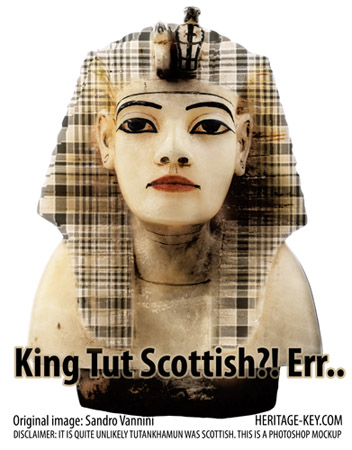 When the latest Tutankhamun study was published in Jama, there were quite a few outcries that although the study looked into the direct ancestry of King Tut, it fully ignored the pointers to the pharoah’s racial ancestry, possibly hidden in the pharaoh’s DNA. As usual, Dr Zahi was accused of many things, most notable charges of ‘hiding that King Tut was black/white/purple.’ Now a retired physicist took the time to write down some of the DNA test results exposed in the Discovery Channel programme that featured the study’s results and concluded the data shown in the docu reveals Tut’s haplogroup as R1b, one of the most common Y-chromosome haplogroups in Europe, especially the United Kingdom. So, err… was Tutankhamun Scottish, rather than black or white?
When the latest Tutankhamun study was published in Jama, there were quite a few outcries that although the study looked into the direct ancestry of King Tut, it fully ignored the pointers to the pharoah’s racial ancestry, possibly hidden in the pharaoh’s DNA. As usual, Dr Zahi was accused of many things, most notable charges of ‘hiding that King Tut was black/white/purple.’ Now a retired physicist took the time to write down some of the DNA test results exposed in the Discovery Channel programme that featured the study’s results and concluded the data shown in the docu reveals Tut’s haplogroup as R1b, one of the most common Y-chromosome haplogroups in Europe, especially the United Kingdom. So, err… was Tutankhamun Scottish, rather than black or white?
From the data exposed in the documentary ‘King Tut Unwrapped’ (start watching at about 1:50 in this video), Whit Athey concluded from the DNA data shown on the documentary that Tutankhamun must have the haplogroup R1b,associated with the male Y chromosome, and common in Ireland, Scotland, western England, France, Iberia and Scandinavia, according to Athey, European through and through. Really?
The exposure of this data was flagged before, with many speculating it was not Tutankhamun’s DNA, but rather test sequences run for the benefit of the documentary. Kate Phizackerley, KV64.info blogger(and a must read if you’re interested in all things Tut), believes the data is genuine, but that Mr Athey’s interpretation might be (way) to quick.
She points out the uncertainty of determining ancestry using the Y chromosome, and that even if R1b is Tut’s haplogroup, that does not necessarily mean he’s European.Some sub-branches of the R1b haplogroup today are mainly found in Sub-Sahara Africa: This branch of R1b is very strongly represented in the Chadric population of Western Sub-Saharan Africa with more than 95% of Cameroonian Ouldemes having an R1b? haplogroup. What is even more striking is that 28% of male the Berbers from Siwa in Egypt still have an R1b? Haplogroup. There is another concentration of R1b in central Aurasia. Phizackerley believes that, if R1b Is indeed Tut’s haplogroup, migrations when the Sahara changed from fertile savannah to desert might account for this.
She calls for the mitochondrial DNA, passed down the maternal line, results to be released (pretty please, Dr Zahi?),as mtDNA is far less likely to mutate than the Y-DNA. The mtDNA would offer a clearer picture of Tutankhamun’s racial ancestry.
But won’t Dr Hawass try to postpone releasing this data as long as possible? For if people keep speculating (Black/White/UK), these ‘ancestry theories’ keep the King Tut hype alive, creating a whole lot of extra, free publicity for Egyptology (and the Egyptology tsar’s books and TV docussuch as Chasing Mummies).Also, as Kate Phizackerley points out, the data is likely to prove that most modern Egyptians are not closely related to the Amarna Royal family, something that could become a major argument in the whole repatriation debate: It is far harder to claim moral ownership of Nefertiti’s bust if most modern Egyptians are themselves genetic incomers rather than direct descendants – at least down the male line.
Personally, I believe King Tut being Scottish as likely as Jesus having visited Cornwall and Somerset. I do want tothink that the Amesbury Archer was born in the French Alps and crossed the Channel to settle at Stonehenge about 4000 years ago. But then again,I also like to believe that he put down a better time for the crossing than those of us who travelled by Eurostar last week.